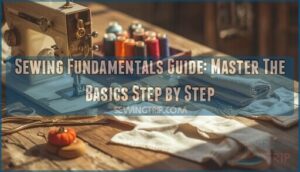This site is supported by our readers. We may earn a commission, at no cost to you, if you purchase through links.
 You tug your fabric from under the presser foot and notice thread loops dangling from the back, puckered seams, or worse—broken thread mid-stitch. More than half of these headaches trace back to one culprit: incorrect thread tension.
You tug your fabric from under the presser foot and notice thread loops dangling from the back, puckered seams, or worse—broken thread mid-stitch. More than half of these headaches trace back to one culprit: incorrect thread tension.
When your top and bobbin threads don’t lock precisely at the fabric’s center, every stitch weakens your seam by 15 to 25 percent and turns clean projects into frustrating do-overs.
Learning to adjust, fix, and perfect your thread tension transforms unpredictable stitching into reliable results, whether you’re tackling delicate silk or wrestling thick canvas.
Table Of Contents
Key Takeaways
- Incorrect thread tension weakens seams by 15-25% and causes visible defects like loops, puckering, and thread breakage, with over half of sewing problems tracing back to improper tension between the top and bobbin threads.
- Start tension adjustments at your machine’s default setting (usually 4-6), make small incremental changes of 0.5, and always test on scrap fabric with contrasting thread colors before touching your actual project—rethreading solves about 80% of tension issues.
- Different fabrics demand specific tension ranges: lightweight materials need 2-3.5 to prevent puckering, thick fabrics require 4.5-6 for proper thread pull-through, and stretchy fabrics work best at 2-3 with polyester thread to maintain elasticity.
- Regular maintenance prevents most tension problems—clean tension discs every 8-10 hours to remove lint buildup that increases resistance by 10-15%, replace needles after 6-8 hours, and maintain 45-55% humidity since environmental conditions can shift tension performance by 20-25%.
Thread Tension Basics
Before you adjust anything on your machine, you need to understand what thread tension actually is and why it matters. Think of tension as the invisible force keeping your stitches locked together—get it wrong, and your seams fall apart or your fabric puckers.
Here’s what you need to know to take control of your stitches.
Definition of Thread Tension
Thread tension is the force your machine applies to both upper and bobbin threads as they travel through tension discs and form stitches. When you thread your machine correctly, those tension discs apply just enough pressure—usually between 120 and 150 grams—to create stitches that lock perfectly at the center of your fabric layers.
Here’s what proper tension calibration achieves:
- Creates stitch balance with threads interlocking exactly between fabric layers
- Prevents visual defects like loops, puckering, or thread gapping
- Eliminates thread breakage during continuous stitching
- Ensures consistent seam strength across your entire project
- Maintains even tension force through all machine components
Understanding thread tension basics means recognizing that balanced stitches look flat and uniform on both fabric sides. Incorrect threading is a common cause of tension issues, so proper thread flow is essential for balanced stitches.
Importance of Balanced Tension
Without proper tension balance, your sewing machine turns into a source of frustration that’ll sabotage your seams before you finish the first inch. Balanced tension means your top and bobbin threads lock exactly at the fabric’s center, creating flat stitches that look identical on both sides. When tension problems appear, you’ll see puckering, loops, or visible thread lines that scream amateur work—and weaken your seam durability by 15 to 25 percent. Stitch quality directly impacts production efficiency, aesthetic outcome, and whether your project survives repeated washing. Correct thread tension is essential for quality embroidery.
| Balanced Tension | Unbalanced Tension |
|---|---|
| Smooth, flat stitches on both sides | Loops, puckering, or visible thread |
| Seams resist fraying and stress | Seams weaken and break easily |
| Works across different fabric types | Requires constant readjustment |
Thread Path in Sewing Machines
Every stitch your machine creates depends on threading sequence—the route from spool pin through guides, tension assembly, take-up lever, and needle eye. This thread path in sewing machines isn’t just mechanical routing; it’s how your machine regulates thread flow and bobbin interaction to lock stitches at the fabric center. When you skip a guide or misthread the tension discs, you’re adding friction that throws off the entire system.
- The tension assembly clamps thread between discs when the presser foot drops, controlling feed rate and compression
- Path maintenance means cleaning guides regularly—lint buildup increases friction by 20 percent and ruins stitch precision
- Automatic systems in newer machines adjust thread pressure in real time based on fabric thickness and thread weight
Tension Settings Adjustments
Getting your tension settings right is easier when you know where to start and what to adjust. You’ll need to make small changes to the top thread dial, check the bobbin case when necessary, and use a reference guide to match your fabric and thread combination.
Let’s walk through each adjustment so you can dial in perfect stitches every time.
Adjusting Top Thread Tension
Your tension dial is command central for perfect stitches. Upper thread tension adjustment controls thread flow between metal tension discs, varying resistance from roughly 15 to 200 grams as you turn the dial. Start at your machine’s default setting—usually between 4 and 6—then make incremental adjustments while testing techniques on scrap fabric.
Follow this adjustment process:
- Start at factory default – Position your tension dial at 4 and thread your upper thread properly through all guides
- Test on matching fabric – Sew trial stitches using the same material you’ll use for your final project
- Adjust by 0.5 increments – Turn clockwise to tighten (higher numbers compress discs), counter-clockwise to loosen
- Check thread intersection – Balanced stitches show threads meeting between fabric layers without visible loops
- Record your settings – Write down successful combinations of fabric type, thread weight, and tension dial settings
Electronic regulators in modern machines maintain consistent drag automatically, but manual adjusting top thread tension still requires your attention. When you’ve achieved balance, you’ll see only upper thread on top and bobbin thread underneath—that’s your sweet spot.
Adjusting Bobbin Tension
Only after you’ve exhausted top thread adjustments should you touch the bobbin case tension screw—this small flat-head fastener compresses the spring controlling your bobbin thread tension. Make adjustments in tiny 1/8-turn increments, testing after each change. A simple drop test method confirms proper tension: suspend your loaded bobbin case by the thread, and it should fall 2.5–5 cm smoothly. Tighter adjustments require clockwise rotation; looser settings need counterclockwise turns.
Mark your starting position before adjusting so you can return to the original setting if needed. Clean out lint buildup under the spring regularly since debris disrupts thread flow and mimics tension problems. After 500 hours of sewing, springs lose elasticity and may need replacement.
For precise bobbin thread tension adjustment, tension gauge usage provides numeric measurements between 18–30 grams-force, eliminating guesswork from your tension screw adjustment process.
Using a Tension Chart
Most sewing machines include a tension chart right in the owner’s manual, and it’s worth keeping that reference handy. This simple guide shows you exactly which tension settings work best for different fabric types and thread weights—no guessing required. Reading results becomes easier when you understand that lightweight fabrics like voile respond well to lower settings around 2–3, while denser materials like canvas need higher numbers up to 5 or 6. Chart standardization means you’ll find similar recommendations across most machines, though you should always test on scraps first.
Modern machine integration has changed the game; many computerized models now adjust tension automatically based on fabric thickness sensors. Still, knowing how to read a traditional tension chart helps you troubleshoot when things go wrong.
- Fabric influence matters: Match your material’s weight to the chart’s recommendations, then fine-tune based on needle size and thread characteristics
- Troubleshooting steps simplify: Charts identify common stitch defects and suggest specific dial adjustments to correct them
- Smart weaving of variables: Consider how thread tension interacts with fabric density and thread type for balanced results
Troubleshooting Tension Issues
Even the best sewing machines can throw you a curveball when tension goes wrong. You’ll need to know what’s causing the problem, how to spot the signs, and what steps to take to fix it.
Let’s walk through the main culprits behind tension trouble and how to get your stitches back on track.
Common Causes of Tension Problems
Threading issues top the list—more than half of all tension problems trace back to skipped guides or threading with the presser foot down. Dirty components like lint-clogged discs or bent needles throw off resistance, while poor thread quality adds extra friction that overloads your machine.
Mismatched needles and fabric create imbalance, and older machines may need calibration as their tension springs lose grip over time.
Identifying Tension Imbalance
Ever notice how your machine seems to speak in code when stitches go sideways? Learning to read those signals transforms frustration into control.
Spotting tension imbalance means examining both sides of your fabric with contrasting thread colors—loops on the underside signal loose upper tension in over 85% of cases, while tiny knots on top reveal overtightened thread pulling the bobbin up. Fabric puckering, thread looping, and skipped stitches all point to unbalanced tension demanding your attention.
Here’s what tension diagnostics reveal:
- Stitch appearance – Check if threads interlock within fabric layers, not on surfaces
- Thread behavior – Watch for breakage or nesting indicating uneven stitches
- Surface inspection – Look for puckering across 10 cm of test seam
- Threading verification – Rethread before adjusting, since improper threading causes 62% of tension problems
Identifying tension imbalance gets easier when you test on scraps first.
Resolving Tension Issues
When troubleshooting tension issues feels like wrestling with invisible gremlins, you need a systematic approach. Rethread your machine completely with the presser foot raised—this solves around 80% of tension problems by ensuring proper engagement with tension discs.
Clear lint buildup from tension springs and bobbin areas, then swap bent needles causing thread quality issues.
If rethreading the machine doesn’t fix uneven stitches, adjust your tension dial in half-number increments while testing on scrap fabric with contrasting threads.
Fixing tension problems requires patience and methodical checks of your entire thread path.
Tension Settings for Fabrics
Different fabrics don’t all play by the same rules regarding tension. What works perfectly on cotton might turn into a mess on silk or jersey.
Let’s look at how to dial in your settings for lightweight, thick, and stretchy materials.
Lightweight Fabrics Tension
Think of lightweight fabrics like silk or cotton voile as thin paper—they won’t tolerate the same handling as denim. You’ll need to lower your sewing machine’s tension settings to around 2.0 to 3.5 for these delicate materials, preventing puckering and thread pull-through that ruins your project. Start at your machine’s default mid-range setting of 4, then decrease by one or two increments while testing on scrap fabric. Fine thread (60wt–80wt) paired with a small needle (70/10) creates the best needle compatibility for clean stitches.
Here’s what makes lightweight fabrics work:
- Lower tension (2-3) stops fabric distortion and visible bobbin dots
- Shorter stitch length (2-2.5mm) prevents seam pulling in thin weaves
- Fine thread weight reduces resistance through tension disks
- Regular calibration maintains repeatable quality across projects
- Clean tension disks prevent common tension issues from humidity
Testing your adjusting thread tension at each increment helps you master these materials.
Thick Fabrics Tension Settings
Working with heavy materials like denim or canvas requires a different approach than the delicate handling used for lightweight fabrics. Increasing tension settings to 4.5–6.0 on a standard machine dial is necessary to pull the bobbin thread up through thicker layers properly. Needle-thread matching is critical—use needles sized 100/16 to 125/20 with heavy-duty polyester or bonded nylon threads (Tex 70–135) to prevent bending and skipped stitches.
Adjusting feed mechanics also helps. Set the stitch length to 3–4mm and consider using a walking foot attachment for consistent layer feeding. Test on fabric scraps first, watching for diagnostic indicators like undersurface loops (tension too low) or surface puckering (tension too high). Lint accumulation in tension discs throws off calibration, so clean the machine after every 10–15 hours of heavy-fabric work. Environmental factors matter—humidity above 60% changes thread elasticity, requiring recalibration by 0.5–1.0 dial units.
| Fabric Type | Tension Range |
|---|---|
| Denim | 4.5–5.5 |
| Canvas | 5.0–6.0 |
| Upholstery | 5.5–6.0 |
| Leather | 4.5–5.5 |
Stretchy Fabrics Tension Requirements
Stretchy fabrics shift the equation entirely from thick materials. Lower your tension settings to 2–3—this prevents seam puckering while letting the fabric maintain its natural give. Polyester thread works best because it can elongate up to 120% before breaking, matching the fabric recoil strength.
Use ballpoint needles to avoid skipped stitches, and test on scraps first. Proper machine calibration ensures stitch integrity, with correctly balanced seams retaining 90% of the fabric’s original stretch capacity. These practical guidelines protect seam elasticity in knits and spandex blends.
Thread Tension Tips Maintenance
Getting your tension right is only half the battle—keeping it that way takes a bit of know-how.
A few simple habits can save you from frustrating stitching problems down the road. Let’s look at practical tips and regular maintenance steps, and how something as simple as the weather can throw your tension off balance.
Practical Tips for Thread Tension
Before you start a project, think of testing as your safety net—it catches tension problems before they show up in your final seams. Using contrasting thread colors on fabric scraps makes tension troubleshooting a breeze; you’ll spot loops or puckering instantly. Here’s how to nail perfect stitches every time:
- Test on scraps: Always run fabric testing with the actual materials you’ll use
- Match your threads: Thread matching between bobbin and needle improves stitch quality by up to 25%
- Log your settings: Consistent logging cuts guesswork in half across different projects
- Pre-wash fabrics: This prevents surprises from shrinkage affecting tension adjustment
- Use contrasting colors: Spot thread tension problems immediately during troubleshooting
Keep these habits sharp, and you’ll develop an instinct for what works with each fabric-thread combo.
Maintaining Sewing Machine Tension
Your machine works hard, so give it the care it deserves—consistent sewing machine maintenance prevents most thread tension problems before they happen. Cleaning tension discs every 8 to 10 hours removes lint buildup that increases resistance by 10 to 15 percent. Oiling mechanisms every few months keeps parts moving smoothly, while needle replacement after 6 to 8 hours maintains accurate thread feed. Thread quality matters too; high-quality options reduce defects by up to 40 percent. Storage conditions also play a role—keep your machine in areas below 65 percent humidity to prevent corrosion in metal tension components.
Maintaining sewing machine essentials for troubleshooting sewing machine issues and fixing common sewing problems:
- Regular cleaning: Monthly lint removal from tension discs and thread guides
- Oiling mechanisms: Bi-monthly lubrication of moving tension assembly parts
- Needle replacement: Fresh needles every 6-8 hours prevent skipped stitches
- Storage conditions: Dry environments preserve tension precision long-term
Humidity Effects on Thread Tension
Your sewing room’s climate can significantly impact thread tension. When relative humidity drops below 30%, threads lose moisture and become brittle. For instance, cotton tensile strength decreases by approximately 8% at 25% humidity compared to 55%. This leads to up to 30% more thread breaks during dry winter months.
The ideal relative humidity (RH) for sewing threads is between 45% and 55%. Within this range, brittleness is prevented, and friction remains balanced, ensuring stable tension and consistent stitches with minimal adjustments. However, above 70% humidity, threads swell and drag through tension discs, requiring recalibration of sewing machine settings.
Different materials respond differently to humidity changes. Polyester remains stable across various humidity levels, while cotton and silk exhibit significant shifts in behavior. To maintain tension stability, controlling environmental factors with a humidistat is essential. This simple step reduces thread tension problems by 20% to 25%, transforming troubleshooting from guesswork into precision.
| Humidity Level | Thread Behavior |
|---|---|
| Below 30% RH | Brittleness, frequent breaks, static buildup |
| 45–55% RH (Ideal) | Stable tension, consistent stitches, minimal adjustments |
| Above 70% RH | Thread swelling, increased friction, tighter tension needed |
| Uncontrolled RH | Unpredictable performance, constant recalibration, frustration |
Advanced Thread Tension Techniques
Once you’ve mastered the basics, you can push your skills further with techniques that go beyond everyday sewing. Decorative stitches, specialty threads, and mixing different fiber types each bring their own tension challenges.
Here’s what you need to know to handle these complex situations with confidence.
Decorative Stitches Tension Requirements
Decorative stitching asks more from your machine than plain seams, and tension adjustments make all the difference. You’ll need to dial down your top tension by one or two numbers since these patterns consume more thread and create complex stitch formations. Here’s what to keep in mind:
- Thread types matter: Metallic threads need 2–4 dial numbers lower to prevent breakage, while rayon works best at tension settings between 2 and 3
- Fabric density drives adjustments: Dense materials like denim require tighter tension (5–6), but delicate silk needs it dropped to around 3
- Stitch symmetry requires testing: Always run samples on scrap fabric and check for balanced thread distribution before starting your project
Slower sewing speeds—around 600 stitches per minute—help maintain stitch density and prevent thread strain during intricate designs.
Machine maintenance plays a role too, since lint buildup in tension discs can throw off your decorative stitching by up to 30 percent.
Specialty Threads Tension Adjustments
With specialty threads, tension adjustments become precision work rather than guesswork. Metallic threads demand the lightest tension—often 1.0 to 2.0—as friction creates heat that weakens or melts these delicate fibers. Monofilament tension needs backing off substantially to prevent stretching that creates visible shine lines across your quilting. Embroidery threads fall somewhere in between, with rayon performing best at 100-120 grams and polyester holding strong at 120-150 grams.
Thread maintenance matters here—thread nets and wax coatings help fragile specialty threads glide through tension discs without shredding.
- Metallic threads: Drop tension to minimal settings and use 65/9 or 75/11 needles to reduce breakage from tight thread paths
- Monofilament tension: Loosen gradually while testing stitch-by-stitch, pairing with 60 sharp needles to minimize fabric holes
- Quilting threads: Heavier 40-weight cotton requires lower tension settings than 50-weight to prevent puckering on quilt tops
Mixing Fiber Types Tension Considerations
Mixing cotton and polyester between needle and bobbin isn’t forbidden—it just demands smart tension adjustment. Cotton’s friction coefficient runs 1.6 times higher than polyester, so you’ll need to bump your top tension up when cotton’s on top.
Thread weight matters more than fiber type: pairing 30-weight polyester upstairs with 60-weight cotton below needs 10-15% less top tension for balanced seams.
Elasticity differences create real problems—polyester stretches 8-12% more than cotton under standard bobbin pressure, causing looping if you don’t compensate.
Humidity effects sneak in too, with cotton absorbing moisture and requiring tension increases by one or two dial clicks in damp weather.
Frequently Asked Questions (FAQs)
How do I know what tension to use when sewing?
Your machine holds the secret, your fabric reveals the truth, and your test seams confirm it. Start at your machine’s default setting—usually around 4—then sew a sample using contrasting thread colors on scrap fabric. Check both sides: perfect stitches lie flat with balanced thread.
Adjust the tension dial in small increments based on fabric weight, thread type, and stitch appearance. A tension chart helps, but test seams always tell the real story.
How do you know if your tension is too high or low?
You’ll spot tension problems by looking at your stitches. High tension creates puckering, thread breaks, and bobbin thread showing on top. Low tension causes loops underneath and weak seams.
Check both fabric sides—perfect stitches look even without any thread show-through.
What tension should I stretch sewing?
Like setting a telegraph dial for delicate news, stretch fabrics need medium tension—usually between 2 and This lower setting prevents puckering and tunneling while allowing stitch elasticity.
Pair polyester thread with ballpoint needles, and test on scraps to balance fabric recovery with seam strength.
Can thread weight affect sewing machine tension?
Absolutely—thread weight directly influences sewing machine tension. Thicker threads like 30-weight require looser tension settings (about 10-20% reduction), while finer 60-weight threads need slightly tighter adjustments.
The tension disc influence changes with thread thickness effects, so you’ll need needle size pairing that matches your material tension interaction for best stitch quality impacts.
How often should tension settings be recalibrated?
You’ll want to check tension every 8-10 hours of sewing or when switching fabric types, thread weights, or needle sizes. Environmental factors like humidity shifts also signal it’s time for adjustments.
Most projects need 2-3 tension tweaks as materials change.
Does needle size impact thread tension balance?
Ever wondered why your stitches look perfect with one needle but fall apart with another? Needle size directly impacts thread tension balance.
Larger needles create bigger fabric holes, reducing friction and requiring tighter tension. Smaller needles grip thread more securely, needing looser settings to prevent puckering and breakage.
Why does tension change during long projects?
Heat buildup, lint accumulation, and thread degradation gradually shift tension during extended sewing projects. Friction-induced heating weakens fibers by 20-30%, while debris in tension discs increases fluctuation ranges by 15%.
Environmental factors like humidity cause additional variations up to 10%, requiring periodic recalibration to maintain consistent stitch quality throughout your project.
Can old thread cause persistent tension problems?
Yes, old thread absolutely causes persistent tension problems. Thread that’s sat around for years becomes brittle and uneven from fiber degradation. When it moves through your tension discs, this brittle thread doesn’t flow smoothly—it catches and drags, creating stitch inconsistency.
Plus, degraded thread sheds more lint buildup that clogs the tension mechanism, making thread quality impossible to maintain consistently.
How does thread type affect tension settings?
Like choosing between nylon rope and cotton twine, different threads pull against your fabric in unique ways. Fiber elasticity, thread weight, construction methods, finishes, and brand consistency all determine your tension settings.
Polyester and nylon need higher tension due to friction, while cotton requires gentler adjustment to prevent puckering.
Can environmental temperature impact thread tension stability?
Temperature swings directly affect tension stability through multiple pathways. Thread materials weaken at high temperatures—around 250°C during high-speed sewing, threads lose roughly 50% of tensile strength. Machine components expand in heat and contract in cold, throwing calibration off. Humidity accelerates corrosion.
Mitigation strategies include controlling environmental factors and regular maintenance.
Conclusion
Think of thread tension as a tightrope walker balancing on a wire—lean too far either direction, and disaster follows. Your thread tension sewing guide knowledge becomes that stabilizing pole, keeping every stitch centered and strong.
When you master these adjustments, you’re not just fixing problems; you’re building confidence that transforms every seam into proof of your growing skill. Perfectly balanced tension doesn’t happen by accident—it’s the reward for understanding your machine, respecting your fabric, and trusting the process you’ve now learned.
- https://madamsew.com/blogs/sewing-blog/how-to-deal-with-thread-tension
- https://www.youtube.com/watch?v=b4JDAkByMlQ
- https://www.echidnasewing.com.au/article/maintenance/thread-tensions-and-common-issues/
- https://www.thesewingdirectory.co.uk/thread-tension/
- https://www.emerald.com/insight/content/doi/10.1108/09556229410054468/full/pdf













